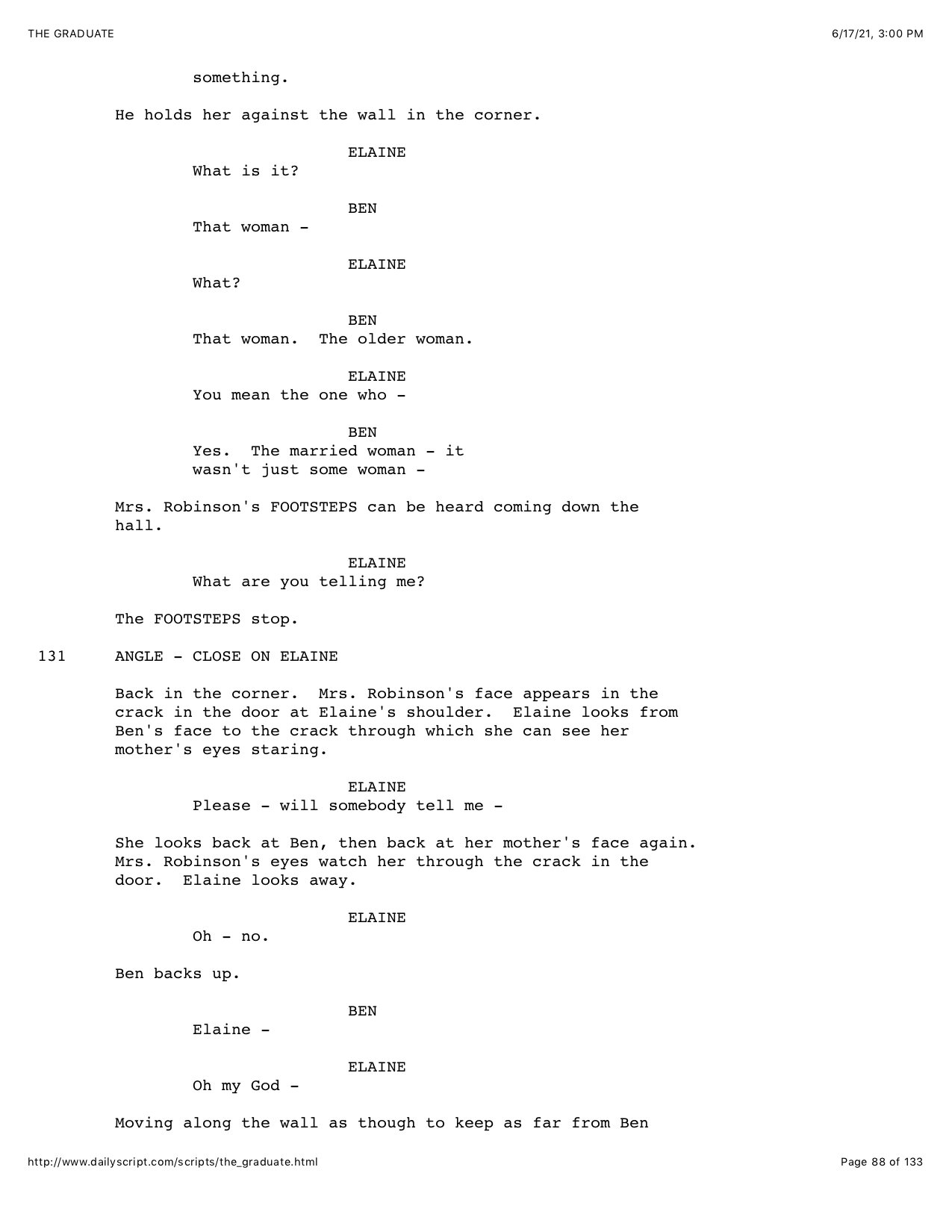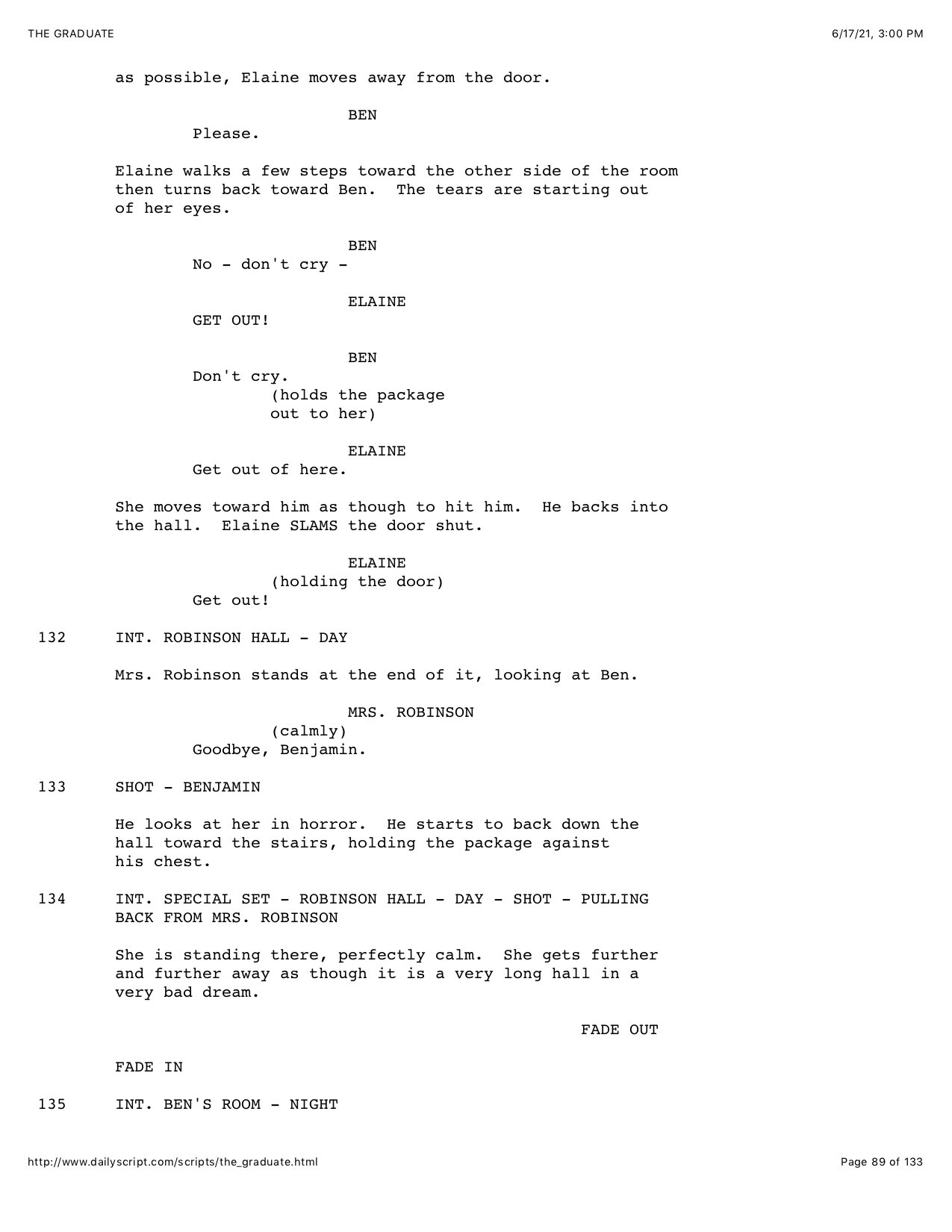Screenplays Through the Decades: 1960s
For the 1960s, we are looking at The Apartment and The Graduate. While these films are great and should be celebrated, it is important to acknowledge the fact there are no women writers on either of them. As I set out to find screenplays from the 1960s, it quickly became apparent how hard it was to find work written by women. The few notable women screenwriters of this time include Jay Presson Allen and Isobel Lennart. While their films can still be watched and enjoyed, finding the actual screenplays proved to be a bigger challenge! I was fully aware of the gender gap that existed in the industry’s history, but I was surprised to see a lack of accessibility to the significant work they have done.
If you’re here, it’s probably because you’re hoping to break down some classic screenplays to learn more about writing. So for that purpose, let’s dive in!
The Apartment (1960)
Written by Billy Wilder and I. A. L Diamond
Directed by Billy Wilder
A brief synopsis:
The Apartment follows Bud, an office worker at an insurance agency, as he attempts to climb the corporate ladder. He lends his apartment to his upper-level colleagues where they can bring their dates without getting caught. Bud tolerates it with the promise of them putting in a good word for him at work, despite it severely interfering with his physical well-being. When Sheldrake, a higher-up, hears about the passing around of Bud’s apartment key, he wants in on it. With this comes a long-awaited promotion for Bud. Unfortunately, the excitement of his shiny new position is short-lived. Bud learns that Fran, the woman he has feelings for, is the one his boss regularly brings to the apartment. When Fran attempts to take her own life in the apartment, Bud is left to pick up the pieces and take the fall for Sheldrake’s actions.
Getting it Made
As discussed by the actors and crew of the film in MGM’s A Look Back: Billy Wilder’s “The Apartment,” Wilder had been holding onto the idea about a poor fool who willingly lent out his apartment since the 1940s, but the Motion Picture Production Code prevented him from writing something that discussed adultery so blatantly (the code was established in 1930 to set a moral standard for films). The code discouraged the inclusion of sex perversion, profanity, the suggestion of nudity, and many other topics that were considered immoral. As the influence of this code dwindled in the 50s, Wilder was able to explore gender and sexuality with Some Like It Hot (1959). After the film proved to be a financial and critical hit, he decided to finally use the idea he had been patiently holding on to. He brought on writing partner, I. A. L Diamond, and knew from the get-go that Jack Lemmon was the one and only actor who could pull off the lead role. Since Wilder directed the film, the script was able to develop as Wilder watched the characters change through the actors’ performances.
A lesson in layered writing:
There are many instances where characters’ lines are layered with more than one meaning. What could be a throwaway line is instead used as a chance to add humor and depth. Characters often refer to things mentioned in past conversations and adopt phrases from each other. When little details are carried through, it helps add weight to what people say. Bud and Fran really listen to each other, helping the progression of their relationship feel natural. An example of this: when Bud recounts a past heartbreak he experienced (he fell in love with his best friend’s wife!), and while his love was never reciprocated, it turned out to be for the best and she now sends him a fruit cake every Christmas. The fruit cake line, though brief, represents the ability to move on. In the final scene between Fran and Bud, Bud asks what she will do about Sheldrake. She refers back to the fruit cake, bringing it full circle. It’s a simple way to that the characters really were listening to each other and valuing each other’s words.
A page-to-screen scene comparison:
In this scene, Bud learns about Fran and Sheldrake.




Favorite lines:
“When you're in love with a married man, you shouldn't wear mascara” – Fran Kubelik
“I said I had no family— I didn't say I had an empty apartment” – C.C. “Bud” Baxter
The Graduate (1967)
Written by Buck Henry and Calder Willingham
Directed by Mike Nichols
A brief synopsis:
The Graduate follows Ben, a recent college graduate, who is paralyzed by the thought of having to face the future. So naturally, he begins an affair with Mrs. Robinson, the wife of his father’s business partner. When he’s not sneaking off to a hotel to be with her, he spends his time aimlessly lingering around his parents’ home with no desire to achieve anything. He is simply moving through the motions. Complications set in when he develops feelings for Mrs. Robinson’s daughter, Elaine. Finally, he has a goal— but the affair lingers over his chance of obtaining the future he now wants.
Getting it made:
As chronicled in the Vanity Fair piece Here’s to You, Mr. Nichols: The Making of The Graduate, the film had to overcome high levels of doubt throughout its entire process. Film producer Lawrence Turman read the original book written by Charles Webb in the early 60s and decided to option the rights for a mere one thousand dollars. He brought on semi-known Broadway director, Mike Nichols, to direct. Unfortunately, neither of their names were enough to pull a major studio’s interest. After a long road of rejection, they finally won over Embassey Pictures’ Joseph E. Levine. Turman signed Calder Willingham as the screenwriter, but he was ultimately unhappy with his “vulgar” take on the book. Despite Buck Henry ultimately writing the screenplay they ended up using, Willingham sued for first billing and won. Though it’s hard to imagine anyone else but Dustin Hoffman and Ann Bancroft in the film, Bancroft was urged to turn down the role while the relatively unknown Hoffman was considered to be a gamble.
A screenwriting lesson in contrasting characters:
One way to effectively display a character’s personality is to place them in situations where they don’t quite fit. Ben’s passive nature is instantly apparent through the stark contrast between him and his family friends. In one instance, he walks through his homecoming party trying to avoid any conversation longer than two sentences. The high-energy guests pester him with questions and praise while he repeatedly alludes to wanting to be alone. This becomes even more apparent when Mrs. Robinson comes into the picture. She knows exactly what she wants from Ben and she’s not afraid to make it known. Even when Ben decides to pursue the affair, he’s still wishy-washy when compared to her unwaveringly comfortable demeanor.
A page-to-screen scene comparison:
In this scene, Elaine learns about about Ben and her mother.





Favorite lines:
“Well, I would say that I'm just drifting. Here in the pool.” – Benjamin Braddock
“Are you here for an affair, sir?” – Hotel Clerk
Thanks for exploring some of the most iconic screenplays of the 1960s with us! Next time we’ll take a look at 2 memorable screenplays from an equally memorable decade: the 1970s.



